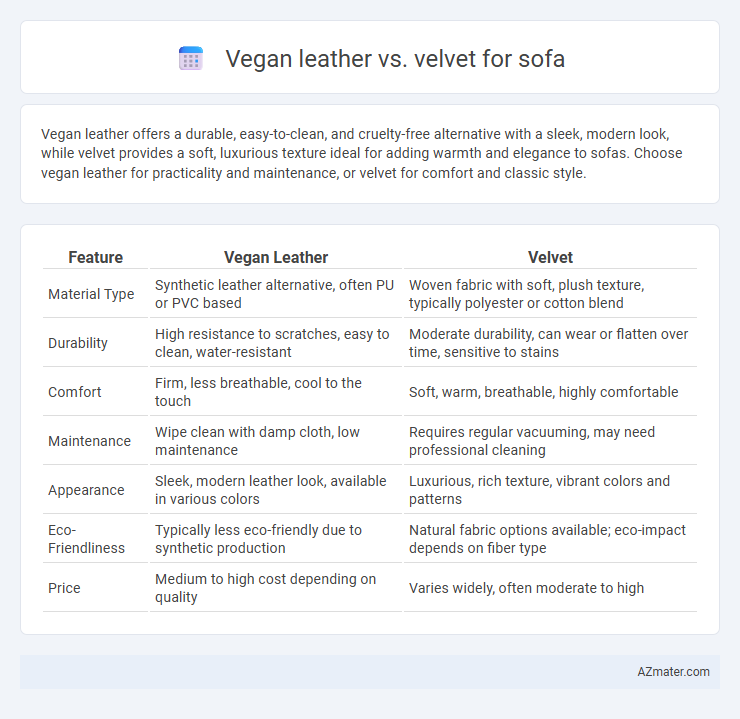Vegan leather offers a durable, easy-to-clean, and cruelty-free alternative with a sleek, modern look, while velvet provides a soft, luxurious texture ideal for adding warmth and elegance to sofas. Choose vegan leather for practicality and maintenance, or velvet for comfort and classic style.
Table of Comparison
| Feature | Vegan Leather | Velvet |
|---|---|---|
| Material Type | Synthetic leather alternative, often PU or PVC based | Woven fabric with soft, plush texture, typically polyester or cotton blend |
| Durability | High resistance to scratches, easy to clean, water-resistant | Moderate durability, can wear or flatten over time, sensitive to stains |
| Comfort | Firm, less breathable, cool to the touch | Soft, warm, breathable, highly comfortable |
| Maintenance | Wipe clean with damp cloth, low maintenance | Requires regular vacuuming, may need professional cleaning |
| Appearance | Sleek, modern leather look, available in various colors | Luxurious, rich texture, vibrant colors and patterns |
| Eco-Friendliness | Typically less eco-friendly due to synthetic production | Natural fabric options available; eco-impact depends on fiber type |
| Price | Medium to high cost depending on quality | Varies widely, often moderate to high |
Introduction to Vegan Leather and Velvet Sofas
Vegan leather sofas offer a sustainable and animal-free alternative crafted from synthetic or plant-based materials, providing durability and easy maintenance. Velvet sofas feature a luxurious, soft fabric made from woven fibers like cotton, silk, or synthetic blends, enhancing elegance and comfort in living spaces. Both options present unique textures and aesthetic appeal, making them popular choices for modern interior design.
Material Composition and Sources
Vegan leather is typically made from polyurethane or natural plant-based materials such as cork or pineapple leaves, offering a synthetic yet animal-free alternative to traditional leather. Velvet, crafted from woven fibers like cotton, silk, or synthetic blends, provides a plush and textured surface ideal for luxurious upholstery. Both materials differ significantly in origin and feel, with vegan leather emphasizing durability and easy maintenance, while velvet focuses on softness and aesthetic richness.
Aesthetic Appeal and Texture
Vegan leather offers a sleek and modern aesthetic with a smooth, uniform texture that is easy to clean and maintain, making it ideal for a contemporary sofa design. Velvet provides a rich, luxurious appearance coupled with a soft, plush texture that adds warmth and depth to any living space. The choice between vegan leather and velvet hinges on the desired blend of visual sophistication and tactile comfort in sofa upholstery.
Comfort and User Experience
Vegan leather offers a smooth, durable surface that is easy to clean and resistant to stains, making it ideal for families with pets or children, while velvet provides a plush, soft texture that enhances comfort and adds a luxurious feel to sofas. Velvet excels in breathability and warmth, creating a cozy seating experience, but requires more maintenance to avoid wear and staining. User experience with vegan leather prioritizes practicality and longevity, whereas velvet focuses on tactile comfort and aesthetic appeal, appealing to different lifestyle needs.
Durability and Longevity
Vegan leather offers high durability and resistance to scratches, stains, and wear, making it an excellent choice for long-lasting sofas. Velvet, while luxurious and soft, is more prone to wear, fading, and staining, requiring more maintenance to preserve its appearance over time. Choosing vegan leather guarantees a sofa that withstands daily use and maintains its look longer compared to velvet upholstery.
Maintenance and Cleaning Requirements
Vegan leather offers easy maintenance with simple wiping using a damp cloth, resisting stains and spills effectively compared to velvet. Velvet requires more careful cleaning, often needing vacuuming and professional cleaning to preserve its texture and color. Spills on velvet can quickly cause stains, whereas vegan leather's non-porous surface makes it more durable and low-maintenance for everyday use.
Environmental Impact and Sustainability
Vegan leather, typically made from polyurethane or plant-based materials like cork and pineapple leaves, offers a more sustainable alternative to traditional leather by reducing reliance on animal products and minimizing deforestation. Velvet, often produced from synthetic fibers such as polyester or natural materials like cotton, varies in environmental impact depending on fiber source and production methods, with synthetic versions contributing to microplastic pollution and natural versions requiring intensive water and pesticide use. Choosing vegan leather sofas crafted from bio-based or recycled materials supports lower carbon emissions and reduced chemical use, whereas sustainably sourced velvet can provide eco-friendly softness but demands careful consideration of resource consumption and biodegradability.
Cost Comparison: Vegan Leather vs Velvet
Vegan leather sofas generally cost more upfront compared to velvet due to the synthetic materials and manufacturing processes involved, yet they offer greater durability and easier maintenance, potentially lowering long-term expenses. Velvet sofas often have a lower initial price but may require more frequent cleaning and careful upkeep, increasing ongoing costs. Considering both material longevity and maintenance, vegan leather presents a cost-effective option for high-traffic use, while velvet suits those prioritizing a plush, luxurious feel with moderate usage.
Allergy Considerations and Pet-Friendliness
Vegan leather offers a hypoallergenic surface resistant to dust mites and pet dander, making it ideal for allergy sufferers and pet owners due to its easy-to-clean nature. Velvet, while luxurious and soft, can trap allergens and pet hair more readily, requiring frequent vacuuming and maintenance to prevent irritation. Choosing vegan leather supports a cleaner, allergen-minimized environment, beneficial for households with sensitive individuals and active pets.
Choosing the Right Sofa Fabric for Your Lifestyle
Vegan leather offers durability, easy maintenance, and a sleek, modern appearance ideal for households with pets or children, while velvet provides a luxurious, soft texture perfect for low-traffic areas prioritizing comfort and elegance. Consider your lifestyle factors such as exposure to spills, cleaning frequency, and aesthetic preferences when selecting between vegan leather and velvet for your sofa fabric. Prioritizing durability and stain resistance favors vegan leather, whereas velvet suits those valuing warmth and tactile richness.

Infographic: Vegan leather vs Velvet for Sofa
 azmater.com
azmater.com